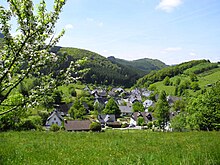Milchenbach
|
Milchenbach
City of Lennestadt
Coordinates: 51 ° 6 ′ 54 ″ N , 8 ° 12 ′ 43 ″ E
|
||
|---|---|---|
| Height : | 400 m above sea level NN | |
| Area : | 7.82 km² | |
| Residents : | 185 (Jun 30, 2020) | |
| Population density : | 24 inhabitants / km² | |
| Postal code : | 57368 | |
| Area code : | 02972 | |
|
Location of Milchenbach in Lennestadt |
||
|
Milchenbach
|
||
Milchenbach is a district of Lennestadt in the Olpe district in North Rhine-Westphalia .
The clustered village is located at the end of the valley at the foot of the Härdler around 2 km south of Lenne at an altitude of around 400 m. The settlement covers an area of 791 hectares. 10% of this is agricultural area and 81% is forest area. At the end of June 2020, 185 people lived in Milchenbach. Adjacent villages are Störmecke , Hundesossen , Lenne and Saalhausen .
history
Milchenbach was first mentioned on December 13, 1297 in a document from the House of Bamenohl . The place belonged to the parish of Lenne. An appraisal register (used to collect taxes) from 1543 provides early clues about the size of Milchenbach at that time. According to this, there were 12 tax obligations in “Molckmecke” (Milchenbach) (excluding 1 person who was considered poor), the number of which should have coincided with the existing families or houses. In 1685, 20 families lived in the village. In 1823 the Milchenbach School was built. Seven years later the village had a total of 175 inhabitants. In 1905 a water pipe was laid. A public telephone was installed in 1907. In 1968, the Paulmann family's stable built in 1724 was dismantled. It was then installed again in the Westphalian Open Air Museum in Detmold . In 1969 the Milchenbach school closed.
The place belonged to the municipality of Lenne until the end of 1974 and was administered by the Kirchhundem office. On January 1, 1975, in the course of municipal reorganization in North Rhine-Westphalia, Lenne was separated and incorporated into the city of Lennestadt.
religion
The vast majority of the Milchenbach population professes the Catholic faith. The first chapel in the village is mentioned in a visit report from 1612. It was replaced in 1778 by a new building dedicated to St. Nicholas was consecrated. Due to the large number of summer guests and youth camps, the premises were no longer sufficient at the beginning of the 1960s. An extension building, designed as a cross in plan, was tackled in August 1965. On May 28, 1967, the new chapel with about 150 seats was inaugurated.
The structural measures are closely linked to the work of the priest and artist Leo Jahn from the Maria Königin monastery and grammar school in Altenhundem. He also looked after Milchenbach pastorally for 35 years from 1964 to 1998. In 1997, Father Jahn gave the Milchenbach Chapel a self-made altarpiece that filled the choir wall and was dominated by the risen Christ.
economy
The place is characterized by agriculture. In mid-2017 it counts twelve agricultural and forestry companies, a timber haulage company and a tractor spare parts trade via the Internet. For the procurement of food, the villagers can fall back on a cottage garden, a meadow orchard and an apiary. The village also has its own water supply.
National competition - our village has a future
Milchenbach began the village competition campaign as early as 1970 with the wish to receive suggestions for improving the village design. The place was awarded in 1989 and 2001 at federal level in the competition Our village should be more beautiful - our village has awarded a gold plaque for the future .
Web links
Individual evidence
- ^ Information from the city of Lennestadt
- ↑ Gräflich Plettenbergsche Archive Heeren, archive part Bamenohl, certificate 2b 2a
- ↑ Treasury register ( memento of October 3, 2011 in the Internet Archive ), page 34
- ^ August Mützell: New topographical-statistical-geographical dictionary of the Prussian state , p. 201, 1822
- ↑ Chronicle - dates and events. In: Hundesossen.de. Archived from the original on February 16, 2004 ; accessed on January 6, 2018 .
- ↑ Stefan Baumeier, Gisbert Strotdrees : Westphalian Open Air Museum Detmold - National Museum of Ethnology. Verlag LWL, ISBN 3926160314 , p. 74.
- ^ Federal Statistical Office (ed.): Historical municipality directory for the Federal Republic of Germany. Name, border and key number changes in municipalities, counties and administrative districts from May 27, 1970 to December 31, 1982 . W. Kohlhammer, Stuttgart / Mainz 1983, ISBN 3-17-003263-1 , p. 336 .
- ^ Ralf Breer and Otto Höffer: Churches and chapels in Attendorn, Lennestadt and Kirchundem. Edited by Sparkasse Attendorn-Lennestadt-Kirchhundem, Attendorn 1999, p. 1110 ff.
- ↑ Religious priest Pater Leo Jahn celebrates his 50th anniversary as a priest. In: Sauerlandkurier (Kurierverlag Lennestadt GmbH), edition of August 8, 2007
- ↑ cf. A village manages itself. In: Westfalenpost , newspaper for the district of Olpe, issue of September 6, 2014.
- ↑ s. Website: golddorf-milchenbach.de, accessed on April 18, 2012





